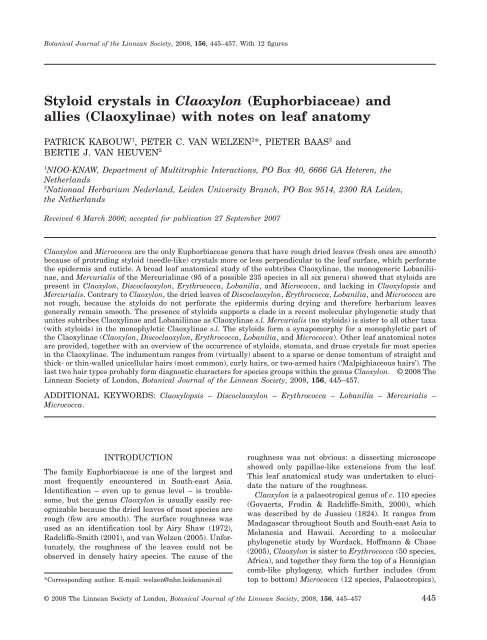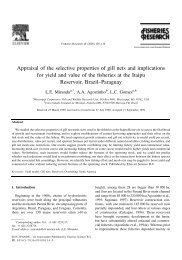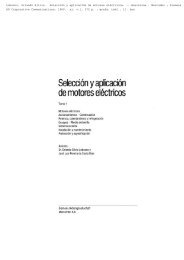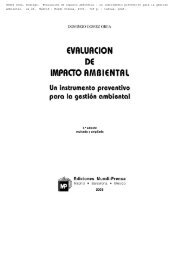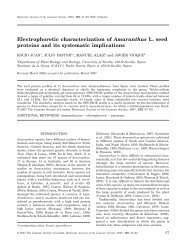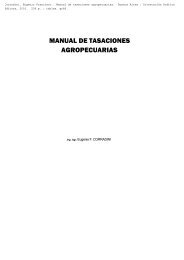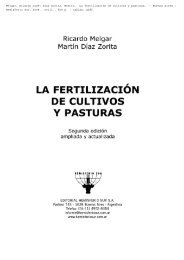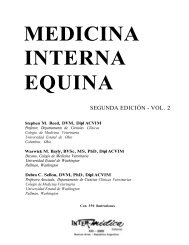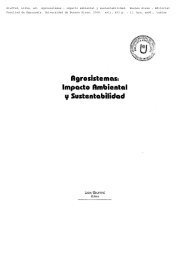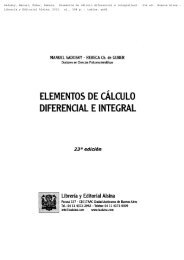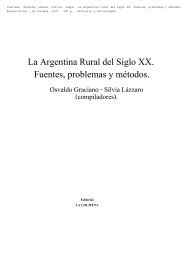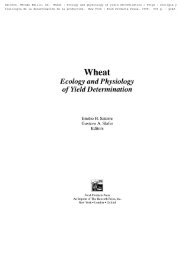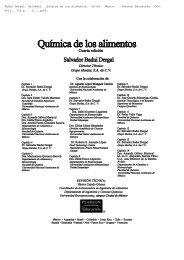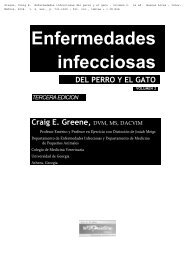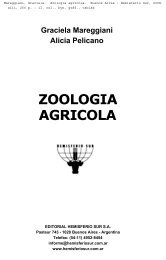Styloid crystals in Claoxylon (Euphorbiaceae) - Red de Bibliotecas
Styloid crystals in Claoxylon (Euphorbiaceae) - Red de Bibliotecas
Styloid crystals in Claoxylon (Euphorbiaceae) - Red de Bibliotecas
You also want an ePaper? Increase the reach of your titles
YUMPU automatically turns print PDFs into web optimized ePapers that Google loves.
Botanical Journal of the L<strong>in</strong>nean Society, 2008, 156, 445–457. With 12 figures<br />
<strong>Styloid</strong> <strong>crystals</strong> <strong>in</strong> <strong>Claoxylon</strong> (<strong>Euphorbiaceae</strong>) and<br />
allies (Claoxyl<strong>in</strong>ae) with notes on leaf anatomy<br />
PATRICK KABOUW 1 , PETER C. VAN WELZEN 2 *, PIETER BAAS 2 and<br />
BERTIE J. VAN HEUVEN 2<br />
1NIOO-KNAW, Department of Multitrophic Interactions, PO Box 40, 6666 GA Heteren, the<br />
Netherlands<br />
2Nationaal Herbarium Ne<strong>de</strong>rland, Lei<strong>de</strong>n University Branch, PO Box 9514, 2300 RA Lei<strong>de</strong>n,<br />
the Netherlands<br />
Received 6 March 2006; accepted for publication 27 September 2007<br />
<strong>Claoxylon</strong> and Micrococca are the only <strong>Euphorbiaceae</strong> genera that have rough dried leaves (fresh ones are smooth)<br />
because of protrud<strong>in</strong>g styloid (needle-like) <strong>crystals</strong> more or less perpendicular to the leaf surface, which perforate<br />
the epi<strong>de</strong>rmis and cuticle. A broad leaf anatomical study of the subtribes Claoxyl<strong>in</strong>ae, the monogeneric Lobanili<strong>in</strong>ae,<br />
and Mercurialis of the Mercurial<strong>in</strong>ae (95 of a possible 235 species <strong>in</strong> all six genera) showed that styloids are<br />
present <strong>in</strong> <strong>Claoxylon</strong>, Discoclaoxylon, Erythrococca, Lobanilia, and Micrococca, and lack<strong>in</strong>g <strong>in</strong> Claoxylopsis and<br />
Mercurialis. Contrary to <strong>Claoxylon</strong>, the dried leaves of Discoclaoxylon, Erythrococca, Lobanilia, and Micrococca are<br />
not rough, because the styloids do not perforate the epi<strong>de</strong>rmis dur<strong>in</strong>g dry<strong>in</strong>g and therefore herbarium leaves<br />
generally rema<strong>in</strong> smooth. The presence of styloids supports a cla<strong>de</strong> <strong>in</strong> a recent molecular phylogenetic study that<br />
unites subtribes Claoxyl<strong>in</strong>ae and Lobanili<strong>in</strong>ae as Claoxyl<strong>in</strong>ae s.l. Mercurialis (no styloids) is sister to all other taxa<br />
(with styloids) <strong>in</strong> the monophyletic Claoxyl<strong>in</strong>ae s.l. The styloids form a synapomorphy for a monophyletic part of<br />
the Claoxyl<strong>in</strong>ae (<strong>Claoxylon</strong>, Discoclaoxylon, Erythrococca, Lobanilia, and Micrococca). Other leaf anatomical notes<br />
are provi<strong>de</strong>d, together with an overview of the occurrence of styloids, stomata, and druse <strong>crystals</strong> for most species<br />
<strong>in</strong> the Claoxyl<strong>in</strong>ae. The <strong>in</strong>dumentum ranges from (virtually) absent to a sparse or <strong>de</strong>nse tomentum of straight and<br />
thick- or th<strong>in</strong>-walled unicellular hairs (most common), curly hairs, or two-armed hairs (‘Malpighiaceous hairs’). The<br />
last two hair types probably form diagnostic characters for species groups with<strong>in</strong> the genus <strong>Claoxylon</strong>. © 2008 The<br />
L<strong>in</strong>nean Society of London, Botanical Journal of the L<strong>in</strong>nean Society, 2008, 156, 445–457.<br />
ADDITIONAL KEYWORDS: Claoxylopsis – Discoclaoxylon – Erythrococca – Lobanilia – Mercurialis –<br />
Micrococca.<br />
INTRODUCTION<br />
The family <strong>Euphorbiaceae</strong> is one of the largest and<br />
most frequently encountered <strong>in</strong> South-east Asia.<br />
I<strong>de</strong>ntification – even up to genus level – is troublesome,<br />
but the genus <strong>Claoxylon</strong> is usually easily recognizable<br />
because the dried leaves of most species are<br />
rough (few are smooth). The surface roughness was<br />
used as an i<strong>de</strong>ntification tool by Airy Shaw (1972),<br />
Radcliffe-Smith (2001), and van Welzen (2005). Unfortunately,<br />
the roughness of the leaves could not be<br />
observed <strong>in</strong> <strong>de</strong>nsely hairy species. The cause of the<br />
*Correspond<strong>in</strong>g author. E-mail: welzen@nhn.lei<strong>de</strong>nuniv.nl<br />
roughness was not obvious: a dissect<strong>in</strong>g microscope<br />
showed only papillae-like extensions from the leaf.<br />
This leaf anatomical study was un<strong>de</strong>rtaken to elucidate<br />
the nature of the roughness.<br />
<strong>Claoxylon</strong> is a palaeotropical genus of c. 110 species<br />
(Govaerts, Frod<strong>in</strong> & Radcliffe-Smith, 2000), which<br />
was <strong>de</strong>scribed by <strong>de</strong> Jussieu (1824). It ranges from<br />
Madagascar throughout South and South-east Asia to<br />
Melanesia and Hawaii. Accord<strong>in</strong>g to a molecular<br />
phylogenetic study by Wurdack, Hoffmann & Chase<br />
(2005), <strong>Claoxylon</strong> is sister to Erythrococca (50 species,<br />
Africa), and together they form the top of a Hennigian<br />
comb-like phylogeny, which further <strong>in</strong>clu<strong>de</strong>s (from<br />
top to bottom) Micrococca (12 species, Palaeotropics),<br />
© 2008 The L<strong>in</strong>nean Society of London, Botanical Journal of the L<strong>in</strong>nean Society, 2008, 156, 445–457 445
446 P. KABOUW ET AL.<br />
Lobanilia (eight species, Madagascar), Discoclaoxylon<br />
(four species, West Africa), and Mercurialis (eight<br />
species, Europe–Asia) (numbers of species and distributions<br />
given <strong>in</strong> Radcliffe-Smith, 2001). The cla<strong>de</strong> has<br />
a bootstrap value of 91% (rbcL data) or 100% (trnL-F<br />
and rbcL and trnL-F comb<strong>in</strong>ed). This cla<strong>de</strong> more or<br />
less co<strong>in</strong>ci<strong>de</strong>s with subtribe Claoxyl<strong>in</strong>ae (subfamily<br />
Acalyphoi<strong>de</strong>ae, tribe Acalypheae), as presented <strong>in</strong> the<br />
last two classifications of the <strong>Euphorbiaceae</strong> by<br />
Webster (1994) and Radcliffe-Smith (2001); these two<br />
classifications are based on morphology and were<br />
built on former systems (for example, Pax & Hoffmann,<br />
1931). Webster (1994) also <strong>in</strong>clu<strong>de</strong>d Amyrea<br />
(11 species, Madagascar), Claoxylopsis (three species,<br />
Madagascar), and Mareya (three species, Africa) <strong>in</strong><br />
Claoxyl<strong>in</strong>ae, but exclu<strong>de</strong>d Lobanilia and Mercurialis.<br />
Radcliffe-Smith (2001) followed Webster <strong>in</strong> his classification,<br />
but, for Claoxyl<strong>in</strong>ae, he <strong>de</strong>viated by exclud<strong>in</strong>g<br />
Amyrea and Mareya. Lobanilia was placed by<br />
both authors <strong>in</strong> the monogeneric subtribe Lobanili<strong>in</strong>ae,<br />
which they consi<strong>de</strong>red to be closely related to<br />
Claoxyl<strong>in</strong>ae (<strong>de</strong>viat<strong>in</strong>g only <strong>in</strong> the presence of stellately<br />
bundled hairs). Mercurialis is part of subtribe<br />
Mercurial<strong>in</strong>ae, which is consi<strong>de</strong>red not to be closely<br />
related to Claoxyl<strong>in</strong>ae. Other studies present<strong>in</strong>g<br />
classifications or discuss<strong>in</strong>g relationships of <strong>Claoxylon</strong><br />
and its allies <strong>in</strong>clu<strong>de</strong> Pax & Hoffmann (1931)<br />
(morphology), Perry (1943) (chromosome counts),<br />
Punt (1962) (palynology), Webster (1975) (precursor of<br />
the 1994 publication), and Nowicke & Takahashi<br />
(2002) (palynology). The phylogenetic relationships<br />
with<strong>in</strong> Claoxyl<strong>in</strong>ae still comprise uncerta<strong>in</strong>ties.<br />
Webster (1994) <strong>in</strong>dicated that the position of Claoxylopsis<br />
and Amyrea requires further evaluation.<br />
Nowicke & Takahashi (2002) presented evi<strong>de</strong>nce<br />
aga<strong>in</strong>st close relationships between Claoxylopsis and<br />
<strong>Claoxylon</strong>, although this evi<strong>de</strong>nce is not very strong.<br />
Unfortunately, Wurdack et al. (2005) did not <strong>in</strong>clu<strong>de</strong><br />
Claoxylopsis <strong>in</strong> their study, but Amyrea and Mareya<br />
are unrelated to each other and the Claoxyl<strong>in</strong>ae, and<br />
both are members of different cla<strong>de</strong>s. Thus, only the<br />
precise position of Claoxylopsis is still unresolved.<br />
Little is known about the leaf anatomy of the genus<br />
<strong>Claoxylon</strong>. Most studies have ma<strong>in</strong>ly conta<strong>in</strong>ed<br />
random observations on only a few species: Solere<strong>de</strong>r<br />
(1908), Pax & Hoffmann (1931), Carey (1938) (comparative<br />
leaf anatomy of species <strong>in</strong> two habitats<br />
around Sydney), Metcalfe & Chalk (1950, 1979)<br />
(general overview), Raju & Rao (1977) (stomata <strong>de</strong>velopment),<br />
and Kulshreshtha & Ahmad (1992) (cuticle<br />
ornamentation). A thorough leaf anatomical study of<br />
<strong>Claoxylon</strong>, certa<strong>in</strong>ly with the purpose of improv<strong>in</strong>g<br />
exist<strong>in</strong>g classifications, is still lack<strong>in</strong>g. Solere<strong>de</strong>r<br />
(1908) was the first to report styloid <strong>crystals</strong> <strong>in</strong> the<br />
leaves of <strong>Claoxylon</strong> (‘<strong>in</strong>clud<strong>in</strong>g Micrococca’). Pax &<br />
Hoffmann (1931: 16) very briefly reported that the<br />
leaf roughness <strong>in</strong> <strong>Claoxylon</strong> and its allies is caused by<br />
crystalliferous cells (‘. .., während die auffallen<strong>de</strong><br />
Rauheit <strong>de</strong>r Blätter von <strong>Claoxylon</strong> und Verwandten<br />
auf die Größe <strong>de</strong>r Kalkoxalat enthalten<strong>de</strong>n Zellen<br />
zurückzuführen ist’) (translated as: ‘while the strik<strong>in</strong>g<br />
roughness of the leaves of <strong>Claoxylon</strong> and allies<br />
can be traced to the size of the cells conta<strong>in</strong><strong>in</strong>g<br />
calcium oxalate’). Kulshreshtha & Ahmad (1992)<br />
provi<strong>de</strong>d notes on the cuticular ornamentation of<br />
<strong>Claoxylon</strong> <strong>in</strong>dicum (Re<strong>in</strong>w. ex Blume) Hassk. and<br />
Micrococca oligandrum L., and Raju & Rao (1977)<br />
reported mucilag<strong>in</strong>ous leaf epi<strong>de</strong>rmal cells for several<br />
(unspecified) <strong>Claoxylon</strong> species <strong>in</strong> their table summariz<strong>in</strong>g<br />
data from other authors.<br />
The roughness of <strong>Claoxylon</strong> leaves prompted this<br />
study. Other genera <strong>in</strong> the Claoxyl<strong>in</strong>ae were also<br />
<strong>in</strong>clu<strong>de</strong>d, because Pax & Hoffmann (1931) <strong>in</strong>dicated<br />
the presence of <strong>crystals</strong> for other related genera. The<br />
aims of this study were to clarify the cause of the<br />
roughness, to establish which species and genera <strong>in</strong><br />
the Claoxyl<strong>in</strong>ae have styloids, to <strong>de</strong>term<strong>in</strong>e whether<br />
the presence of roughness and/or <strong>crystals</strong> can be<br />
used to <strong>de</strong>limit systematic groups, and to record<br />
other leaf anatomical <strong>de</strong>tails of potential systematic<br />
significance.<br />
MATERIAL AND METHODS<br />
Herbarium specimens (see Appendix) of <strong>Claoxylon</strong>,<br />
Claoxylopsis, Erythrococca, Lobanilia, Micrococca,<br />
and Mercurialis were sampled <strong>in</strong> L (Lei<strong>de</strong>n, the Netherlands),<br />
and specimens of Discoclaoxylon ma<strong>in</strong>ly<br />
orig<strong>in</strong>ated from WAG (Wagen<strong>in</strong>gen, the Netherlands).<br />
The follow<strong>in</strong>g species were sampled: 74 of c. 110<br />
<strong>Claoxylon</strong> species (five represented by two specimens),<br />
one of three Claoxylopsis species, one of four<br />
Discoclaoxylon species (three specimens), eight of<br />
c. 50 Erythrococca species (two represented by two<br />
specimens), one of eight Lobanilia species, four of<br />
eight Mercurialis species, and six of 12 Micrococca<br />
species (one represented by two specimens). A liv<strong>in</strong>g<br />
specimen of <strong>Claoxylon</strong> longifolium (Blume) Endl. was<br />
checked for roughness by Richard Chung and colleagues<br />
of the Forest Research Institute, Kepong,<br />
Malaysia (KEP). It was impossible to acquire samples<br />
of all genera; Amyrea and Mareya were not <strong>in</strong>clu<strong>de</strong>d.<br />
Leaf roughness was noted for the adaxial and abaxial<br />
surfaces.<br />
The leaves were rehydrated <strong>in</strong> boil<strong>in</strong>g water. Crosssections<br />
(15, 20, 25, or 30 mm thick) of small leaf<br />
samples were taken from the middle of the lam<strong>in</strong>a<br />
with a Reichert sledge microtome. The sections<br />
were sta<strong>in</strong>ed for 5 m<strong>in</strong> with Etzold’s colour solution<br />
(solution of 0.01% basic fuchs<strong>in</strong> + 0.04% safran<strong>in</strong>e<br />
O + 0.15% astrablue <strong>in</strong> 2% acetic acid) and mounted<br />
<strong>in</strong> glycer<strong>in</strong>e–gelat<strong>in</strong>e (Wal<strong>de</strong>ck, Germany).<br />
© 2008 The L<strong>in</strong>nean Society of London, Botanical Journal of the L<strong>in</strong>nean Society, 2008, 156, 445–457
Cuticular macerations were ma<strong>de</strong> by leav<strong>in</strong>g leaf<br />
samples overnight at 60 °C <strong>in</strong> a mixture of 30%<br />
hydrogen peroxi<strong>de</strong> and glacial (99–100%) acetic acid<br />
(1 : 1), sta<strong>in</strong><strong>in</strong>g for 3 h with Sudan IV 0.5% <strong>in</strong> alcohol<br />
70% heated to 40 °C, and mount<strong>in</strong>g <strong>in</strong> glycer<strong>in</strong>e–<br />
gelat<strong>in</strong>e. Photographs were taken with a SIS Colorview<br />
1 digital camera. The frequency and size of the<br />
styloids and the druse-like or clustered <strong>crystals</strong> were<br />
observed with polarized light.<br />
Measurements were performed us<strong>in</strong>g AnalySIS<br />
docu software and, <strong>in</strong> general, 15 po<strong>in</strong>ts were measured<br />
per specimen. Measurements were taken of the<br />
thickness of the leaves (measured <strong>in</strong> between the<br />
styloids), length of the styloids, thickness of the epi<strong>de</strong>rmis<br />
and cuticle, and frequency of the styloids. The<br />
frequencies of <strong>in</strong>tact styloids were counted over a<br />
standard length (714 mm) of the lam<strong>in</strong>a <strong>in</strong> polarized<br />
light. The frequencies were then standardized to a<br />
thickness of the cross-sections of 15 mm (for example,<br />
the frequency of a lam<strong>in</strong>a, 30 mm thick, was divi<strong>de</strong>d<br />
by two). Most of the results are presented <strong>in</strong> Table 1<br />
(data on epi<strong>de</strong>rmis and cuticle thickness are not<br />
provi<strong>de</strong>d, see ‘Discussion’).<br />
The leaves used for scann<strong>in</strong>g electron microscopy<br />
were <strong>de</strong>hydrated with alcohol 95% and acetone, air<br />
dried, coated with gold for 6 m<strong>in</strong> us<strong>in</strong>g a Bal-Tec SCD<br />
005 sputter coater, studied with a JEOL JSM-5300<br />
scann<strong>in</strong>g electron microscope, and photographed<br />
us<strong>in</strong>g the computer program SEMaFORE. The photographs<br />
were used to <strong>de</strong>term<strong>in</strong>e whether or not<br />
styloids protru<strong>de</strong>d from the epi<strong>de</strong>rmis.<br />
The elements mak<strong>in</strong>g up the crystal type were<br />
i<strong>de</strong>ntified us<strong>in</strong>g a Philips XL20 equipped with an<br />
energy-dispersive X-ray analysis (EDAX) X-ray<br />
system (25 kV; work<strong>in</strong>g distance, 12 mm). The styloids<br />
were sputter coated with carbon us<strong>in</strong>g a Paar<br />
B50/200R carbon sputter.<br />
RESULTS<br />
GENERAL ANATOMY<br />
The follow<strong>in</strong>g general leaf anatomical <strong>de</strong>tails are<br />
observed <strong>in</strong> the Claoxyl<strong>in</strong>ae (Table 1).<br />
Trichomes/papillae: In most species, trichomes are<br />
present, but no papillae are found. Five types of<br />
trichome can be dist<strong>in</strong>guished.<br />
1. Thick-walled, straight to curved, unicellular,<br />
po<strong>in</strong>ted slen<strong>de</strong>r hairs (Fig. 1; long hairs).<br />
2. Thick-walled, unicellular, curly hairs (C. coriaceolanatum,<br />
C. lutescens, and C. nubicola) (Fig. 4;<br />
Table 1; character 11).<br />
3. Relatively th<strong>in</strong>-walled, unicellular hairs that are<br />
less slen<strong>de</strong>r than types 1 and 2 and have blunt tips<br />
(Fig. 1; short hairs).<br />
LEAF ANATOMY OF CLAOXYLON AND ALLIES 447<br />
4. Two-armed, thick-walled, unicellular hairs<br />
(‘Malpighiaceous hairs’) with slen<strong>de</strong>r, po<strong>in</strong>ted<br />
arms of unequal length (<strong>in</strong> a group of species from<br />
New Gu<strong>in</strong>ea and the Pacific: C. ech<strong>in</strong>ospermum,<br />
C. fallax, C. le<strong>de</strong>rmannii, C. microcarpum, C. parvicoccum,<br />
C. pauc<strong>in</strong>erve, C. putii, C. sandwicense,<br />
C. taitense, and C. vitiense) (Figs 3, 7; Table 1;<br />
character 11). In several species, the hairs are<br />
<strong>in</strong>termediate between types 1, 2, and 3, and<br />
possess short ‘second arm stubs’ (Fig. 2).<br />
5. Whereas types 1–4 have rather narrow hair bases,<br />
a fifth unicellular hair type occurr<strong>in</strong>g <strong>in</strong> Mercurialis<br />
has a very broad base and is larger <strong>in</strong> size.<br />
6. Lobanilia is the only genus with stellately bundled<br />
simple hairs of type 1 (Fig. 5; Table 1; character<br />
11).<br />
Stomata: All species have paracytic stomata (Fig. 3)<br />
that are almost exclusively restricted to the abaxial<br />
surface. Only a few species <strong>in</strong> Claoxyl<strong>in</strong>ae also have<br />
adaxial stomata that occur at lower <strong>de</strong>nsity than<br />
abaxially. These are sometimes restricted to the epi<strong>de</strong>rmal<br />
areas overly<strong>in</strong>g the ve<strong>in</strong>s (Table 1; character<br />
2).<br />
Cuticle: Cuticular striations are found <strong>in</strong> some<br />
species of <strong>Claoxylon</strong>, Micrococca, and Erythrococca.<br />
As reported by Kulshreshtha & Ahmad (1992), striations<br />
often run perpendicular to the pores around<br />
stomata.<br />
Hypo<strong>de</strong>rmis: The hypo<strong>de</strong>rmis is ma<strong>in</strong>ly lack<strong>in</strong>g, but<br />
species <strong>in</strong> <strong>Claoxylon</strong> (Fig. 8; Table 1; character 1)<br />
possess a cont<strong>in</strong>uous hypo<strong>de</strong>rmis.<br />
Mesophyll: The mesophyll is uniformly dorsiventral<br />
(Fig. 7). The spongy tissue varies from compact<br />
(Fig. 7) to very lacunar.<br />
Epi<strong>de</strong>rmis: There is much variation <strong>in</strong> the outl<strong>in</strong>e of<br />
the anticl<strong>in</strong>al epi<strong>de</strong>rmal cell walls, often with differences<br />
between adaxial and abaxial cells. The abaxial<br />
cells have more s<strong>in</strong>uous anticl<strong>in</strong>al walls and the<br />
adaxial epi<strong>de</strong>rmis has straighter walls. The variation<br />
with<strong>in</strong> and between species was not consi<strong>de</strong>red,<br />
because, <strong>in</strong> general, only one specimen per species<br />
was studied.<br />
CRYSTALS<br />
Most genera and species <strong>in</strong> the Claoxyl<strong>in</strong>ae possess<br />
styloids, a special type of crystal, which are long,<br />
slen<strong>de</strong>r, and sharply po<strong>in</strong>ted (Figs 6, 7, 10). The<br />
X-rays showed that they are composed of calcium<br />
oxalate (<strong>in</strong> agreement with Pax & Hoffmann, 1931).<br />
<strong>Styloid</strong>s are found <strong>in</strong> <strong>Claoxylon</strong>, Discoclaoxylon,<br />
© 2008 The L<strong>in</strong>nean Society of London, Botanical Journal of the L<strong>in</strong>nean Society, 2008, 156, 445–457
448 P. KABOUW ET AL.<br />
Table 1. Observed and measured leaf anatomical characters of Claoxyl<strong>in</strong>ae<br />
Taxon<br />
Character<br />
1 2 3 4 5 6 7 8 9 10 11<br />
<strong>Claoxylon</strong> abbreviatum – – + + + 171 141 – 1.3 2<br />
<strong>Claoxylon</strong> albicans – – + + + 91 99 + 1.6 2<br />
<strong>Claoxylon</strong> brachyandrum (Teijsmann HB 10758) – – + + ? 180 121 – 7.6 3<br />
<strong>Claoxylon</strong> brachyandrum (Vriese & Teijsmann) – – +/– + + 92 85 – 4.3 3<br />
<strong>Claoxylon</strong> caerulescens – – +/– + + 108 63 – 0.6 1<br />
<strong>Claoxylon</strong> capillipes – – + + + 167 150 – 0.8 1<br />
<strong>Claoxylon</strong> car<strong>in</strong>atum – – + + + 85 121 + 1<br />
<strong>Claoxylon</strong> carol<strong>in</strong>eanum – – + + + 147 133 – 0.9 1<br />
<strong>Claoxylon</strong> carrii – – + + + 193 123 – 1.3 2<br />
<strong>Claoxylon</strong> cent<strong>in</strong>arium – – +/– + +/– 88 70 – 2.4 2<br />
<strong>Claoxylon</strong> colfsii – – + + + 100 122 + 1.6 2<br />
<strong>Claoxylon</strong> collenettei – – +/– + +/– 232 101 – 6.4 3<br />
<strong>Claoxylon</strong> coriaceolanatum – – +/– + +/? 163 66 – 3.7 3 C<br />
<strong>Claoxylon</strong> cuneatum – + + + + 105 79 – 3<br />
<strong>Claoxylon</strong> cuspidatum – – + + + 51 82 + 1.8 2<br />
<strong>Claoxylon</strong> dolichostachyum + – +/– + + 342 242 – 1<br />
<strong>Claoxylon</strong> ech<strong>in</strong>ospermum (A.C. Smith 7524) – – + + +/– 201 181 – 2.0 2 T<br />
<strong>Claoxylon</strong> ech<strong>in</strong>ospermum (A.C. Smith 7547) – – +/– + + 201 125 – 3.2 3 T<br />
<strong>Claoxylon</strong> ellipticum – – + + + 115 118 + 2.1 2<br />
<strong>Claoxylon</strong> erythrophyllum – – +/– + +/– 121 126 + 1.9 2<br />
<strong>Claoxylon</strong> euphorbioi<strong>de</strong>s – – + + + 122 133 + 1.6 2<br />
<strong>Claoxylon</strong> extenuatum – – + + +/– 57 60 + 1.0 2<br />
<strong>Claoxylon</strong> fallax – – +/– + +/– 256 174 – 2.2 2 T<br />
<strong>Claoxylon</strong> frutescens – – +/– + – 139 128 – 3.7 3<br />
<strong>Claoxylon</strong> gillisonii – – + + + 119 160 + 1.7 2<br />
<strong>Claoxylon</strong> glabrifolium – – +/– + +/– 121 103 – 1.6 2<br />
<strong>Claoxylon</strong> glandulosum + – + + –/+ 164 154 – 0.3 1<br />
<strong>Claoxylon</strong> goo<strong>de</strong>noviense – – + + + 135 125 – 1.3 2<br />
<strong>Claoxylon</strong> grandifolium – – + + + 118 107 – 0.2 1<br />
<strong>Claoxylon</strong> gymna<strong>de</strong>num – – +/– + +/– 92 108 + 3.0 3<br />
<strong>Claoxylon</strong> ha<strong>in</strong>anensis – – – + – 92 50 – 1<br />
<strong>Claoxylon</strong> helleri + – +/– + +/? 284 190 – 1.0 2<br />
<strong>Claoxylon</strong> hirsutellum – – +/– + + 82 117 + 3.2 3<br />
<strong>Claoxylon</strong> <strong>in</strong>dicum – – +/– + + 99 118 + 3.0 3<br />
<strong>Claoxylon</strong> <strong>in</strong>sulanum – – +/– + + 148 1229 – 4.0 3<br />
<strong>Claoxylon</strong> khasianum – – +/– + +/– 82 68 – ?<br />
<strong>Claoxylon</strong> k<strong>in</strong>abaluense – – + + + 136 122 – 2.4 2<br />
<strong>Claoxylon</strong> k<strong>in</strong>gii – – +/– + ? 122 69 – 1<br />
<strong>Claoxylon</strong> le<strong>de</strong>rmanii – – + + +/– 186 194 + 2.6 2 T<br />
<strong>Claoxylon</strong> longifolium (Blume 1395) – – + + + 92 77 – 2.0 2<br />
<strong>Claoxylon</strong> longifolium (Keßler PK 1895) – + + + + 132 98 – 3.7 3<br />
<strong>Claoxylon</strong> lutescens (NGF 32016) – – +/– + + 147 113 – 5.0 3 C<br />
<strong>Claoxylon</strong> lutescens (En<strong>de</strong>rt 2396) – – +/– + +/? 132 103 – 7.5 3 C<br />
<strong>Claoxylon</strong> mananarense – – – + – 137 94 – 2.4 2<br />
<strong>Claoxylon</strong> marianum + – + + +/– 143 113 – 4.7 3<br />
<strong>Claoxylon</strong> microcarpum – – + + + 90 124 + 2.0 2 T<br />
<strong>Claoxylon</strong> monoicum – – + + +/– 236 193 – 0.3<br />
<strong>Claoxylon</strong> muscisilvae – – + + + 92 101 + 3.0 3<br />
<strong>Claoxylon</strong> nubicola – – +/– + + 316 124 – ? 1 C<br />
<strong>Claoxylon</strong> oliganthum – – – + – 283 103 – 1.0 2<br />
<strong>Claoxylon</strong> papuae – – + + + 150 142 – 2.3 2<br />
© 2008 The L<strong>in</strong>nean Society of London, Botanical Journal of the L<strong>in</strong>nean Society, 2008, 156, 445–457
Table 1. Cont<strong>in</strong>ued<br />
Taxon<br />
LEAF ANATOMY OF CLAOXYLON AND ALLIES 449<br />
Character<br />
1 2 3 4 5 6 7 8 9 10 11<br />
<strong>Claoxylon</strong> parvicoccum – – + + + 179 158 – 3.0 3 T<br />
<strong>Claoxylon</strong> parviflorum – – +/– + ? 190 176 – 2.0 2<br />
<strong>Claoxylon</strong> pauc<strong>in</strong>erve – – + + + 116 122 + 2.0 2 T<br />
<strong>Claoxylon</strong> physocarpum – – + + + 132 169 + 2.0 2<br />
<strong>Claoxylon</strong> platyphyllum – – +/– + –/? 192 114 – 3<br />
<strong>Claoxylon</strong> porphyrostemon +/– – – + – 217 74 – 3<br />
<strong>Claoxylon</strong> praetermissum – + + + + 134 120 – 2.5 2<br />
<strong>Claoxylon</strong> psilogyne – – + + +/– 75 101 + 1.3 2<br />
<strong>Claoxylon</strong> purpureum – – – + – 112 70 – 1<br />
<strong>Claoxylon</strong> putii – – – + – 85 45 – 1<br />
<strong>Claoxylon</strong> racemiflorum + – + + + 178 143 – 3.0 3<br />
<strong>Claoxylon</strong> salic<strong>in</strong>um – – – + – 125 112 – 2.9 2<br />
<strong>Claoxylon</strong> salomonense – – + + +/– 158 145 – 4.3 3<br />
<strong>Claoxylon</strong> sanctaecrucis – – + + –/+ 95 103 + 1.2 2<br />
<strong>Claoxylon</strong> sandwicense – – + + + 166 104 – 1.0 2 T<br />
<strong>Claoxylon</strong> scabratum – – + + + 233 171 – 2.7 2 T<br />
<strong>Claoxylon</strong> stapfianum – – + + + 151 144 – 1.3 2<br />
<strong>Claoxylon</strong> subbullatum – – + + – 157 97 – 1<br />
<strong>Claoxylon</strong> subviri<strong>de</strong> – + + + + 179 102 – 4.3 3<br />
<strong>Claoxylon</strong> taitense – – +/– + ? 206 86 – 3 T<br />
<strong>Claoxylon</strong> tenerifolium (Pullen 6879) – – – + – 152 116 – 5.0 3<br />
<strong>Claoxylon</strong> tenerifolium (Stocker 903) – – – + +/– 259 110 – 1.0 2<br />
<strong>Claoxylon</strong> tenuiflorum – – + + + 140 160 + 3.3 3<br />
<strong>Claoxylon</strong> tetracoccum – + +/– + ?/– 114 87 – 3<br />
<strong>Claoxylon</strong> tumidum – – + + +/– 85 124 + 2.0 2<br />
<strong>Claoxylon</strong> velut<strong>in</strong>um – – +/– + –/+ 113 107 – 3<br />
<strong>Claoxylon</strong> vitiense – – +/– + +/? 143 97 – 3 T<br />
<strong>Claoxylon</strong> wallichianum – – +/– + – 104 94 – 1<br />
Claoxylopsis perrieri – + +/– – X 47 0<br />
Discoclaoxylon hexandrum (Andoh 5690) – – – + – 152 138 – 1<br />
Discoclaoxylon hexandrum (Versteegh 741) – – – + – 202 ? 1<br />
Discoclaoxylon hexandrum (Zenker 2790) – – +/– + +/– 148 140 – 1.0 2<br />
Erythrococca anomale – – – + – 150 94 – 8.4 3<br />
Erythrococca atrovirens – – – + – 112 91 – 3.1 3<br />
Erythrococca bougensis – – – + – 137 120 – 2.7 2<br />
Erythrococca columnaris – – – + – 84 129 + 1.5 2<br />
Erythrococca fischeri – – – + – 87 49 – 0.4 1<br />
Erythrococca kirkii – + – + – 143 113 – 2.7 2<br />
Erythrococca trichogyne (Maas Geesteranus 5245) – – +/– + – 144 126 – 3.0 3<br />
Erythrococca trichogyne (Stolz 1556) – – – + – 97 68 – 1.2 2<br />
Erythrococca welwitschiana (Zenker 3913) – – +/– + – 100 90 – 1<br />
Erythrococca welwitschiana (Zenker 4912) – – +/– + +/– 123 116 – 4.0 3<br />
Lobanilia luteobrunnea* – – ? + – ? ? S<br />
Mercurialis annua – – – – X 0 0 0.0<br />
Mercurialis jordani – – – – X 0 0 0.0<br />
Mercurialis leiocarpa – – – – X 0 0 0.0<br />
Mercurialis ovata – – – – X 0 0 0.0<br />
Micrococca lancifolia – – + + + 161 151 – 1.6 2<br />
Micrococca malaccensis – – – – X 0 0 0.0<br />
Micrococca mercurialis (SF 39822) – – + + + 120 132 + 3.0 3<br />
© 2008 The L<strong>in</strong>nean Society of London, Botanical Journal of the L<strong>in</strong>nean Society, 2008, 156, 445–457
450 P. KABOUW ET AL.<br />
Table 1. Cont<strong>in</strong>ued<br />
Taxon<br />
Erythrococca, Lobanilia, and all but one species of<br />
Micrococca. Micrococca malaccensis lacks styloids<br />
(Table 1; character 4). The <strong>crystals</strong> are absent <strong>in</strong><br />
Claoxylopsis and Mercurialis (Table 1). The styloids<br />
are positioned more or less perpendicular to the leaf<br />
surface (strongly oblique <strong>crystals</strong> also occur), often<br />
runn<strong>in</strong>g from cuticle to cuticle (Fig. 7). When they are<br />
short, they are present <strong>in</strong> the adaxial or abaxial part<br />
of the mesophyll.<br />
In Erythrococca, the leaves generally feel smooth<br />
and the styloids do not protru<strong>de</strong> from the surface<br />
(Figs 11, 12) with two exceptions: E. hirta feels rough,<br />
but has no protrud<strong>in</strong>g styloids; E. welwitschiana only<br />
feels rough adaxially where styloids protru<strong>de</strong> somewhat<br />
(Table 1; characters 3 and 5). In dried leaves of<br />
Erythrococca, the epi<strong>de</strong>rmis usually wr<strong>in</strong>kles around<br />
the styloids, whereby the styloids act as a k<strong>in</strong>d of tent<br />
pole elevat<strong>in</strong>g the epi<strong>de</strong>rmis <strong>in</strong>to small pyramids<br />
(Fig. 11). Discoclaoxylon also has nonprotrud<strong>in</strong>g or<br />
only very slightly protrud<strong>in</strong>g styloids (tip only;<br />
Fig. 12) <strong>in</strong> leaves that are smooth to the touch.<br />
In <strong>Claoxylon</strong> and Micrococca, the leaves generally<br />
feel rough and the styloids usually penetrate through<br />
the epi<strong>de</strong>rmis (Figs 6, 10; Table 1; characters 3 and 5),<br />
although this is not always the case. Some species feel<br />
smooth and have no protrud<strong>in</strong>g styloids (C. oliganthum,<br />
C. porphyrostemon, C. purpureum, C. putii,<br />
and C. tenerifolium), <strong>de</strong>spite the fact that styloids are<br />
present. In some species, the leaves feel (partly)<br />
smooth, either because the styloids protru<strong>de</strong> at very<br />
low <strong>de</strong>nsity (C. ha<strong>in</strong>anensis) or on one si<strong>de</strong> only<br />
(C. hillii).<br />
The <strong>de</strong>nsity of the styloids is variable between<br />
species, but a correlation with roughness is not<br />
Character<br />
1 2 3 4 5 6 7 8 9 10 11<br />
Micrococca mercurialis (Stolz 1207) – – + + + 153 131 – 0.8 1<br />
Micrococca oligandra – – + + + 125 112 – 3.5 3<br />
Micrococca wightii – – + + + 180 126 – 3.0 3<br />
Character 1, hypo<strong>de</strong>rmis (+, present; +/–, only locally <strong>de</strong>veloped); character 2, stomata also present on adaxial surface (+)<br />
or restricted to abaxial epi<strong>de</strong>rmis (–); character 3, leaf roughness (–, smooth; +/–, unclear; +, rough; adaxial/abaxial);<br />
character 4, styloids (–, absent; +, present); character 5, protrusion of styloids (–, not protrud<strong>in</strong>g; +, protrud<strong>in</strong>g; –/+ or +/–,<br />
protrud<strong>in</strong>g either adaxially or abaxially; X, styloids absent); character 6, lam<strong>in</strong>a thickness <strong>in</strong> mm; character 7, length of<br />
styloids <strong>in</strong> mm; character 8, relative length of styloids (–, shorter than leaf thickness; +, longer); character 9, styloid<br />
frequency (number of <strong>in</strong>tact styloids over length of 714 mm standardized to a section with a thickness of 15 mm); character<br />
10, styloid frequency classes (1, frequency < 1; 2, 1 < frequency < 3; 3, frequency 3); character 11, presence of special hair<br />
types (normal straight unicellular hairs not noted) (C, curly unicellular hairs; S, unicellular hairs <strong>in</strong> stellate bundles; T,<br />
two-armed hairs).<br />
*The quality of the microscopic sli<strong>de</strong> was too poor to see a good transverse section, and thus only qualitative characters<br />
are noted.<br />
directly evi<strong>de</strong>nt. The smooth <strong>Claoxylon</strong> species may<br />
have a high <strong>de</strong>nsity of styloids (for example, C. porphyrostemon<br />
feels smooth, but has <strong>de</strong>nsity class 3;<br />
Table 1), and rough species may have few styloids<br />
(for example, C. crassifolium feels very rough, but has<br />
<strong>de</strong>nsity class 1; Table 1). The length of the <strong>crystals</strong> is<br />
variable between the species (Table 1; character 7). In<br />
<strong>Claoxylon</strong>, there is also no correlation between roughness<br />
and the length of the styloids and/or the thickness<br />
of the leaf bla<strong>de</strong>. <strong>Claoxylon</strong> caerulescens has very<br />
short styloids (63 mm on average), a thick leaf lam<strong>in</strong>a<br />
(108 mm), and feels rough, whereas C. car<strong>in</strong>atum has<br />
styloids (121 mm) much longer than the leaf bla<strong>de</strong><br />
thickness (85 mm <strong>in</strong> the partly rehydrated state), but<br />
is only slightly rough. Both species have a low crystal<br />
<strong>de</strong>nsity.<br />
In addition to the styloid <strong>crystals</strong>, there are also<br />
druses and/or clustered <strong>crystals</strong> present <strong>in</strong> most<br />
species of <strong>Claoxylon</strong>, Claoxylopsis, Erythrococca,<br />
Lobanilia, Mercurialis, and Micrococca (no dist<strong>in</strong>ction<br />
could be ma<strong>de</strong> between these two <strong>in</strong>tergrad<strong>in</strong>g types,<br />
druses be<strong>in</strong>g the more regularly star-shaped version<br />
of clustered <strong>crystals</strong>). There is some variation <strong>in</strong> the<br />
location of druses or clusters <strong>in</strong> the leaf. In some<br />
species, they are only found near the ve<strong>in</strong>s, but, <strong>in</strong><br />
other species, they are also found throughout the<br />
chlorenchyma of the mesophyll. When the druses/<br />
clusters are present <strong>in</strong> the chlorenchyma, they are<br />
also present <strong>in</strong> the bundle sheaths of the ve<strong>in</strong>s, and<br />
sometimes also <strong>in</strong> the phloem of the vascular bundles.<br />
Moreover, <strong>in</strong> some species, styloids gradually <strong>in</strong>tergra<strong>de</strong><br />
with much shorter, solitary, nonpo<strong>in</strong>ted <strong>crystals</strong><br />
that range to diamond-shaped or rhombic. The abundance<br />
of these crystal types varies wi<strong>de</strong>ly.<br />
© 2008 The L<strong>in</strong>nean Society of London, Botanical Journal of the L<strong>in</strong>nean Society, 2008, 156, 445–457
LEAF ANATOMY OF CLAOXYLON AND ALLIES 451<br />
Figures 1–6. Figures 1–5. Various hair types present <strong>in</strong> <strong>Claoxylon</strong> and Lobanilia. Figure 1. <strong>Claoxylon</strong> <strong>in</strong>dicum with type<br />
1 (thick-walled, straight to curved, unicellular, po<strong>in</strong>ted, slen<strong>de</strong>r hairs) and type 3 (relatively th<strong>in</strong>-walled, unicellular hairs<br />
that are less slen<strong>de</strong>r than type 1 with blunt tips) hairs on abaxial surface. Scale bar, 200 mm. Figure 2. <strong>Claoxylon</strong><br />
car<strong>in</strong>atum, abaxial surface, unicellular hair with short second arm ‘stub’. Scale bar, 50 mm. Figure 3. Abaxial view of<br />
C. ech<strong>in</strong>ospermum with type 4 hairs (‘Malpighiaceous’, two-armed); note the paracytic stomata. Scale bar, 50 mm. Figure 4.<br />
<strong>Claoxylon</strong> coreaceolanatum, abaxial surface, with type 2 hairs (thick-walled, unicellular, curly). Scale bar, 50 mm. Figure 5.<br />
Lobanilia luteobrunnea with stellately fascicled hairs on the abaxial surface. Scale bar, 200 mm. Figure 6. Protrud<strong>in</strong>g<br />
styloid crystal on the adaxial surface of C. subviri<strong>de</strong>. Scale bar, 10 mm.<br />
© 2008 The L<strong>in</strong>nean Society of London, Botanical Journal of the L<strong>in</strong>nean Society, 2008, 156, 445–457
452 P. KABOUW ET AL.<br />
Figures 7–12. <strong>Styloid</strong>s <strong>in</strong> <strong>Claoxylon</strong> and Erythrococca. Figure 7. Transverse section of C. vitiense show<strong>in</strong>g a styloid on the<br />
right penetrat<strong>in</strong>g the upper epi<strong>de</strong>rmis, and, on the left, a type 4 ‘Malpighiaceous’ two-armed hair. Scale bar, 50 mm.<br />
Figure 8. Transverse section through a leaf of C. racemiflorum show<strong>in</strong>g the hypo<strong>de</strong>rmis and two styloids, which probably<br />
penetrated the upper epi<strong>de</strong>rmis and cuticle <strong>in</strong> vivo. Scale bar, 50 mm. Figure 9. Upper leaf surface of C. parvicoccum<br />
show<strong>in</strong>g two sites (arrows) where styloids probably penetrated the epi<strong>de</strong>rmis <strong>in</strong> vivo, but <strong>in</strong> this case did not perforate<br />
the cuticle. Scale bar, 50 mm. Figure 10. Adaxial leaf surface of C. fallax show<strong>in</strong>g the protrusion of the styloids after<br />
dry<strong>in</strong>g; this leaf feels rough. Scale bar, 50 mm. Figure 11. Adaxial leaf surface of dried leaf of E. columnaris. The styloids<br />
cause tent-like elevations that generally do not penetrate the epi<strong>de</strong>rmis and cuticle. This leaf is smooth to the touch. Scale<br />
bar, 100 mm. Figure 12. Detail of Figure 11, show<strong>in</strong>g tent-like elevation with modified cuticle at the apex. Scale bar, 10 mm.<br />
© 2008 The L<strong>in</strong>nean Society of London, Botanical Journal of the L<strong>in</strong>nean Society, 2008, 156, 445–457
DISCUSSION<br />
The presence of styloids <strong>in</strong> the leaves of this group of<br />
genera seems to be unique <strong>in</strong> <strong>Euphorbiaceae</strong>. It is<br />
also a rare phenomenon <strong>in</strong> other dicotyledonous families.<br />
Metcalfe & Chalk (1983) listed 26 families <strong>in</strong><br />
which styloids occur, usually only <strong>in</strong> a small m<strong>in</strong>ority<br />
of the genera (cf. Metcalfe & Chalk, 1950). Large<br />
styloids, sometimes referred to as ‘megastyloids’, such<br />
as the largest styloids <strong>in</strong> <strong>Claoxylon</strong> and its relatives,<br />
are even less common.<br />
It may seem obvious that styloids will cause<br />
surface roughness, but this is not self-evi<strong>de</strong>nt. A<br />
genus such as Mercurialis lacks styloids and has<br />
smooth leaves. On the other hand, Claoxylopsis also<br />
lacks styloids, but the leaves feel slightly rough.<br />
<strong>Claoxylon</strong> species possess styloids and usually feel<br />
rough (exceptions occur; for example, C. oliganthum<br />
is smooth), but Erythrococca and Discoclaoxylon<br />
(styloids present) are generally smooth to the touch.<br />
The leaf surface texture of Lobanilia luteobrunnea is<br />
entirely <strong>de</strong>term<strong>in</strong>ed by its <strong>de</strong>nse <strong>in</strong>dumentum, and<br />
cannot be compared with the less hairy Claoxyl<strong>in</strong>ae.<br />
The difference <strong>in</strong> roughness is caused by the fact<br />
that, <strong>in</strong> dried leaves, the styloids <strong>in</strong> <strong>Claoxylon</strong> and<br />
Micrococca perforate the epi<strong>de</strong>rmis and protru<strong>de</strong><br />
from it (Figs 6, 10), whereas, <strong>in</strong> Erythrococca and<br />
Discoclaoxylon, the styloids do not or only very<br />
slightly perforate the epi<strong>de</strong>rmis, not sufficiently to<br />
cause any roughness to the touch (Figs 11, 12).<br />
Usually, the epi<strong>de</strong>rmis rema<strong>in</strong>s <strong>in</strong>tact and folds over<br />
the tip of the <strong>crystals</strong> (Fig. 11). Thus, perforat<strong>in</strong>g<br />
styloids give rise to rough leaves, whereas leaves<br />
with nonperforat<strong>in</strong>g styloids (even though these can<br />
be much longer than the dry leaf thickness) generally<br />
rema<strong>in</strong> smooth.<br />
Some exceptions still occur: there are several<br />
smooth-leaved <strong>Claoxylon</strong> species (Table 1) and several<br />
(somewhat) rough Erythrococca species. These are<br />
difficult to expla<strong>in</strong>, because the roughness is not<br />
caused by the length of the part of the styloids that<br />
extends beyond the cuticle (as suggested by Pax &<br />
Hoffmann, 1931), or by the frequency of the styloids.<br />
Smooth-leaved <strong>Claoxylon</strong> species sometimes have<br />
longer <strong>crystals</strong> than many species with rough leaves,<br />
but they all have <strong>crystals</strong> that are much shorter than<br />
the leaf thickness. However, many rough-leaved<br />
species also have <strong>crystals</strong> much shorter than the leaf<br />
thickness. This may be expla<strong>in</strong>ed by the fact that the<br />
sharply po<strong>in</strong>ted styloids may more easily perforate<br />
the epi<strong>de</strong>rmis than the mesophyll tissues. Thus, <strong>in</strong><br />
some species with thick leaves, the short styloids are<br />
able to perforate the leaves, but <strong>in</strong> other species they<br />
are not. Another explanation may be that differences<br />
<strong>in</strong> pressure dur<strong>in</strong>g the dry<strong>in</strong>g process may result <strong>in</strong><br />
perforation or not.<br />
LEAF ANATOMY OF CLAOXYLON AND ALLIES 453<br />
Several of the figures (Figs 8, 9, 12) <strong>in</strong>dicate that<br />
the styloid-conta<strong>in</strong><strong>in</strong>g cells are surroun<strong>de</strong>d by modified<br />
epi<strong>de</strong>rmal cells, suggest<strong>in</strong>g that styloids may<br />
already penetrate the epi<strong>de</strong>rmis and cuticle slightly<br />
<strong>in</strong> vivo. This could not be confirmed with liv<strong>in</strong>g<br />
material. Perforation of the cuticle <strong>in</strong> vivo is<br />
counter-<strong>in</strong>tuitive, because it would make the leaves<br />
vulnerable to microbial <strong>in</strong>fection and disease. All<br />
fresh leaves of <strong>Claoxylon</strong> probably feel smooth. This<br />
has been confirmed for C. longifolium by the KEP<br />
herbarium staff (Richard Chung, Forest Research<br />
Institute, Kepong, Malaysia, pers. comm.), who<br />
checked trees <strong>in</strong> the arboretum. The leaves of fresh<br />
C. longifolium, whether grow<strong>in</strong>g <strong>in</strong> the sun or sha<strong>de</strong>,<br />
are smooth; the leaves become rough only on dry<strong>in</strong>g.<br />
Seem<strong>in</strong>gly, this is the case with most <strong>Claoxylon</strong> and<br />
Micrococca species. However, further research on the<br />
<strong>de</strong>velopment of styloids and their <strong>in</strong>teraction with<br />
epi<strong>de</strong>rmal cells and the cuticle <strong>in</strong> liv<strong>in</strong>g material of<br />
several species is clearly nee<strong>de</strong>d.<br />
The fact that dried leaves of Micrococca generally<br />
feel rough was a surprise. In this study, ma<strong>in</strong>ly<br />
African species were <strong>in</strong>clu<strong>de</strong>d. Two species from Asia<br />
were also exam<strong>in</strong>ed. One was the rough-leaved<br />
M. mercurialis (resembl<strong>in</strong>g <strong>Claoxylon</strong>, but differ<strong>in</strong>g <strong>in</strong><br />
its small leaves and herbaceous habit). Two Micrococca<br />
species are en<strong>de</strong>mic to the Malay Pen<strong>in</strong>sula:<br />
M. johorica and M. malaccensis (Sagun & van<br />
Welzen, 2002). Only M. malaccensis was <strong>in</strong>clu<strong>de</strong>d <strong>in</strong><br />
this study and this species lacks styloids altogether<br />
(M. johorica was not <strong>in</strong>clu<strong>de</strong>d). Both species were<br />
<strong>de</strong>scribed by Airy Shaw (1971), who expressed doubts<br />
about their <strong>in</strong>clusion <strong>in</strong> Micrococca. The absence of<br />
styloids <strong>in</strong> at least M. malaccensis suggests that this<br />
species might have to be transferred to another<br />
genus, but a likely candidate is not obvious.<br />
It is still unclear why the styloids penetrate the<br />
cuticle <strong>in</strong> <strong>Claoxylon</strong> and Micrococca, but not <strong>in</strong> the<br />
other genera. We attempted to <strong>de</strong>term<strong>in</strong>e whether<br />
there was a difference <strong>in</strong> the epi<strong>de</strong>rmis/cuticle thickness<br />
between the genera, but no difference was found;<br />
moreover, with<strong>in</strong> <strong>Claoxylon</strong>, cuticular penetration<br />
occurred through a wi<strong>de</strong> range of thicknesses of both<br />
pericl<strong>in</strong>al cell walls and cuticles. The styloids <strong>in</strong><br />
all genera have a similar appearance, with sharp,<br />
oblique, angular tips that look very suitable for<br />
cutt<strong>in</strong>g through the cuticle (Fig. 10). Therefore, the<br />
absence of epi<strong>de</strong>rmal penetration (or only slight penetration;<br />
Figs 9, 12) by styloids <strong>in</strong> Erythrococca and<br />
Discoclaoxylon is curious.<br />
A few species possess a hypo<strong>de</strong>rmis (Table 1; character<br />
1). It is not clear whether, ontogenetically, this<br />
layer should be consi<strong>de</strong>red as a multiple epi<strong>de</strong>rmis or<br />
a true hypo<strong>de</strong>rmis. Cuticular ornamentations are<br />
often observed. These are sometimes caused by the<br />
styloids, because the surfaces are wr<strong>in</strong>kled around<br />
© 2008 The L<strong>in</strong>nean Society of London, Botanical Journal of the L<strong>in</strong>nean Society, 2008, 156, 445–457
454 P. KABOUW ET AL.<br />
the tip of the styloids <strong>in</strong> Erythrococca (Figs 11, 12),<br />
Discoclaoxylon, and some species of <strong>Claoxylon</strong> and<br />
Micrococca. Striations perpendicular to the stomatal<br />
pore also occur frequently around the paracytic<br />
stomata, as noted by Kulshreshtha & Ahmad (1992).<br />
The gelat<strong>in</strong>ization of the epi<strong>de</strong>rmis (Raju & Rao,<br />
1977) could not be confirmed <strong>in</strong> this study.<br />
Several species are represented by two or three<br />
accessions. The results show that variability is<br />
present <strong>in</strong> the leaf thickness, styloid length and<br />
<strong>de</strong>nsity, and, to a lesser <strong>de</strong>gree, protrusion of the<br />
styloids. The largest differences are found <strong>in</strong> E. welwitschiana<br />
and M. mercurialis, where the <strong>de</strong>nsity of<br />
the styloids differs between class 1 and 3, and one<br />
specimen of E. welwitschiana has slightly protrud<strong>in</strong>g<br />
styloids <strong>in</strong>stead of nonprotrud<strong>in</strong>g ones. However, the<br />
variability is not of a sufficient magnitu<strong>de</strong> to affect<br />
our conclusions.<br />
A limited number of species possess curly (three<br />
species) and two-armed (11 species) hairs (Table 1;<br />
character 11). Most of these are classified <strong>in</strong> <strong>Claoxylon</strong><br />
section Indica Pax & K.Hoffm., some <strong>in</strong> <strong>Claoxylon</strong><br />
section Aff<strong>in</strong>ia Pax & K.Hoffm., and some <strong>in</strong> both. Only<br />
C. sandwicense is <strong>in</strong> a different (monotypic) section:<br />
<strong>Claoxylon</strong> section Gymnoclaoxylon Müll.Arg. The sectional<br />
classification of Pax & Hoffmann (1914) does not<br />
appear to be reliable, because several species can be<br />
classified <strong>in</strong> more than one section (for example, C. microcarpum<br />
and C. pauc<strong>in</strong>erve), and authors of new<br />
species usually refra<strong>in</strong> from plac<strong>in</strong>g them <strong>in</strong> one of the<br />
sections. Still, it is possible that the exceptional hair<br />
types represent synapomorphies. The species with<br />
two-armed hairs all occur <strong>in</strong> New Gu<strong>in</strong>ea and the West<br />
Pacific up to Hawaii. The species with curly hairs are<br />
only found <strong>in</strong> New Gu<strong>in</strong>ea at higher altitu<strong>de</strong>s.<br />
Species <strong>in</strong> <strong>Claoxylon</strong> section Luteobrunnea Pax &<br />
K.Hoffm. were placed <strong>in</strong> a separate genus (Lobanilia)<br />
and subtribe (Lobanili<strong>in</strong>ae) by Radcliffe-Smith (1989)<br />
because of the simple hairs <strong>in</strong> stellate bundles (Fig. 5).<br />
The presence of styloids <strong>in</strong> Lobanilia and Claoxyl<strong>in</strong>ae<br />
confirms the results of the phylogenetic study by<br />
Wurdack et al. (2005), <strong>in</strong> which Lobanilia is part of the<br />
Claoxyl<strong>in</strong>ae cla<strong>de</strong>. The molecular study and our anatomical<br />
results show that Lobanili<strong>in</strong>ae should be<br />
united with Claoxyl<strong>in</strong>ae. <strong>Claoxylon</strong>, Discoclaoxylon,<br />
Erythrococca, Lobanilia, and Micrococca all possess<br />
styloids. This group also forms a subcla<strong>de</strong> <strong>in</strong> the<br />
molecular study of Wurdack et al. (2005). The styloids<br />
are a synapomorphy for this group, which may be<br />
referred to as Claoxyl<strong>in</strong>ae s.l. We can confirm that<br />
Claoxylopsis and Mercurialis are not part of this<br />
restricted group. Claoxylopsis was placed tentatively<br />
<strong>in</strong> the Claoxyl<strong>in</strong>ae by Webster (1994). Nowicke &<br />
Takahashi (2002) showed the pollen to be of a different<br />
type than that of the Claoxyl<strong>in</strong>ae, <strong>in</strong>dicat<strong>in</strong>g that it<br />
should be classified <strong>in</strong> another group of <strong>Euphorbiaceae</strong>.<br />
Mercurialis, with another hair type and a lack of<br />
styloids, is <strong>in</strong><strong>de</strong>ed different from the Claoxyl<strong>in</strong>ae s.l.<br />
It was <strong>in</strong>clu<strong>de</strong>d <strong>in</strong> this study because it was the local<br />
outgroup/sister to the Claoxil<strong>in</strong>ae <strong>in</strong> the molecular<br />
phylogenetic study by Wurdack et al. (2005). Neither<br />
this study, nor that of Wurdack et al. (2005), discusses<br />
or changes the taxonomic position of Mercurialis,<br />
which is ma<strong>in</strong>ta<strong>in</strong>ed <strong>in</strong> the subtribe Mercurial<strong>in</strong>ae.<br />
In conclusion, the leaf roughness <strong>in</strong> Claoxyl<strong>in</strong>ae<br />
s.l. (<strong>in</strong>clud<strong>in</strong>g Lobanili<strong>in</strong>ae) is caused by protrud<strong>in</strong>g<br />
styloid <strong>crystals</strong>. The presence of the styloids is a good<br />
synapomorphy for a monophyletic subcla<strong>de</strong> of the<br />
Claoxyl<strong>in</strong>ae (<strong>Claoxylon</strong>, Discoclaoxylon, Erythrococca,<br />
Lobanilia, and Micrococca) as circumscribed by<br />
Webster (1994), Radcliffe-Smith (2001), and Wurdack<br />
et al. (2005).<br />
ACKNOWLEDGEMENTS<br />
We wish to thank the curators of the herbaria L and<br />
WAG for supply<strong>in</strong>g us with leaf samples. Richard<br />
Chung and colleagues (Forest Research Institute,<br />
Kepong, Malaysia) are thanked for check<strong>in</strong>g the<br />
roughness of fresh leaves of <strong>Claoxylon</strong>. Professor H.<br />
Sieghardt, W. Klepal, and D. Gruber (University of<br />
Vienna, Austria) are thanked for the use of the EDAX<br />
system. We would also like to thank an anonymous<br />
reviewer for extremely useful comments.<br />
REFERENCES<br />
Airy Shaw HK. 1971. Notes on Malesian and other Asiatic<br />
<strong>Euphorbiaceae</strong>. CXXXVII. Two new species of Micrococca<br />
Benth. from Malaya. Kew Bullet<strong>in</strong> 25: 524–526.<br />
Airy Shaw HK. 1972. The <strong>Euphorbiaceae</strong> of Siam. Kew<br />
Bullet<strong>in</strong> 26: 233–234.<br />
Airy Shaw HK. 1980. The <strong>Euphorbiaceae</strong> of New Gu<strong>in</strong>ea.<br />
Kew Bullet<strong>in</strong> Additional Series 8: 1–243.<br />
Carey G. 1938. Comparative anatomy of leaves from species<br />
<strong>in</strong> two habitats around Sydney. Proceed<strong>in</strong>gs of the L<strong>in</strong>nean<br />
Society of New South Wales 63: 439–450.<br />
Govaerts R, Frod<strong>in</strong> DG, Radcliffe-Smith A. 2000. World<br />
checklist and bibliography of <strong>Euphorbiaceae</strong> 1 (with Pandaceae).<br />
Kew: Royal Botanical Gar<strong>de</strong>ns.<br />
<strong>de</strong> Jussieu A. 1824. De Euphorbiacearum generibus medicisque<br />
earum<strong>de</strong>m viribus tentamen. Paris: Didot, 43.<br />
Kulshreshtha K, Ahmad KJ. 1992. Cuticular ornamentations<br />
<strong>in</strong> some genera of <strong>Euphorbiaceae</strong>. Fed<strong>de</strong>s Repertorium<br />
103: 5–6, 317–326.<br />
Metcalfe CR, Chalk L. 1950. Anatomy of the dicotyledons,<br />
Vol. 2. Oxford: Clarendon Press.<br />
Metcalfe CR, Chalk L. 1979 & 1983. Anatomy of the dicotyledons,<br />
Vol.1&2,2n<strong>de</strong>dn.Oxford: Clarendon Press.<br />
Nowicke JW, Takahashi WM. 2002. Pollen morphology,<br />
ex<strong>in</strong>e structure and systematics of Acalyphoi<strong>de</strong>ae (<strong>Euphorbiaceae</strong>),<br />
Part 4: Tribes Acalypheae pro parte (Erythrococca,<br />
<strong>Claoxylon</strong>, Claoxylopsis, Mareya, Mareyopsis, Discoclaoxy-<br />
© 2008 The L<strong>in</strong>nean Society of London, Botanical Journal of the L<strong>in</strong>nean Society, 2008, 156, 445–457
lon, Micrococca, Amyrea, Lobanilia, Mallotus, Deuteromallotus,<br />
Cor<strong>de</strong>moya, Cococceras, Trewia, Neotrewia, Rock<strong>in</strong>ghamia,<br />
Octospermum, Acalypha, Lasiococca, Spathiostemon,<br />
Homonoia), Plukenetieae (Haematostemon, Astrococcus,<br />
Angostyles, Romanoa, Eleutherostigma, Plukenetia, Vigia,<br />
Cnesmone, Megistostigma, Sphaerostylis, Tragiella,<br />
Platygyna, Tragia, Acidoton, Pachystylidium, Dalechampia),<br />
Omphaleae (Omphalea), and discussion and summary of the<br />
complete subfamily. Review of Paleobotany and Palynology<br />
121: 231–336.<br />
Pax F, Hoffmann K. 1914. <strong>Euphorbiaceae</strong>-Acalypheae-<br />
Mercurial<strong>in</strong>ae. In: Engler A, ed. Das Pflanzenreich IV. 147.<br />
vii. Leipzig: Wilhelm Engelmann, 100–131.<br />
Pax F, Hoffmann K. 1931. <strong>Euphorbiaceae</strong>. In: Engler A,<br />
Harms H, eds. Die natürlichen Pflanzenfamilien, 2nd edn.,<br />
Part 19c. Leipzig: Wilhelm Engelmann, 11–233.<br />
Perry BA. 1943. Chromosome number and phylogenetic<br />
relationships <strong>in</strong> the <strong>Euphorbiaceae</strong>. American Journal of<br />
Botany 30: 527–543.<br />
Punt W. 1962. Pollen morphology of the <strong>Euphorbiaceae</strong> with<br />
special reference to taxonomy. Wentia 7: 1–116.<br />
Radcliffe-Smith A. 1989. Notes on Madagascan <strong>Euphorbiaceae</strong><br />
II. <strong>Claoxylon</strong> Sect. Luteobrunnea. Kew Bullet<strong>in</strong> 44:<br />
333–340.<br />
Radcliffe-Smith A. 2001. Genera Euphorbiacearum. Kew:<br />
Royal Botanical Gar<strong>de</strong>ns.<br />
Raju VS, Rao PN. 1977. Variation <strong>in</strong> the structure and<br />
<strong>de</strong>velopment of foliar stomata <strong>in</strong> the <strong>Euphorbiaceae</strong>. Botanical<br />
Journal of the L<strong>in</strong>nean Society 75: 69–97.<br />
Sagun VG, van Welzen PC. 2002. Revision of the Malesian<br />
species of Micrococca (<strong>Euphorbiaceae</strong>). Blumea 47: 149–155.<br />
Solere<strong>de</strong>r H. 1908. Systematische Anatomie <strong>de</strong>r Dicotyledonen.<br />
Ergänzungsband, 286. Stuttgart: Ferd<strong>in</strong>and Enke.<br />
Webster GL. 1975. Conspectus of a new classification of the<br />
<strong>Euphorbiaceae</strong>. Taxon 24: 593–601.<br />
Webster GL. 1994. Synopsis of the genera and suprageneric<br />
taxa of <strong>Euphorbiaceae</strong>. Annals of the Missouri Botanical<br />
Gar<strong>de</strong>n 81: 33–144.<br />
van Welzen PC. 2005. <strong>Claoxylon</strong>. In: Chayamarit K, van<br />
Welzen PC, eds. Flora of Thailand, Vol. 8, Part 1. Bangkok:<br />
The Forest Herbarium, 159.<br />
Wurdack KJ, Hoffmann P, Chase MW. 2005. Molecular<br />
phylogenetic analysis of uniovulate <strong>Euphorbiaceae</strong> (<strong>Euphorbiaceae</strong><br />
sensu stricto) us<strong>in</strong>g plastid rbcL and trnl-F DNA<br />
sequences. American Journal of Botany 92: 1397–1420.<br />
APPENDIX<br />
LIST OF SPECIMENS SAMPLED FOR THE LEAF<br />
ANATOMICAL STUDIES<br />
All material <strong>in</strong> L unless stated otherwise. The<br />
full label <strong>in</strong>formation is available at http://<br />
www.nationaalherbarium.nl.<br />
<strong>Claoxylon</strong> abbreviatum Airy Shaw: Indonesia,<br />
Sumatra, Junghuhn 529 (L 0164220).<br />
<strong>Claoxylon</strong> albicans (Blanco) Merr.: Philipp<strong>in</strong>es,<br />
Luzon, Vanoverbergh 188 (L 0164429; formerly<br />
C. elongatum Merr.).<br />
LEAF ANATOMY OF CLAOXYLON AND ALLIES 455<br />
<strong>Claoxylon</strong> brachyandrum Pax & K.Hoffm.: Indonesia,<br />
Lesser Sunda Islands, Teijsmann HB 10758<br />
(L 0164321); Indonesia, Moluccas, Banda, Vriese &<br />
Teijsmann s.n. (L 0164325).<br />
<strong>Claoxylon</strong> caerulescens Ridl.: Christmas Island (south<br />
of Java), B.A. Mitchell 43 (L 0164334). Treated by<br />
Govaerts et al. (2000) as a synonym of C. <strong>in</strong>dicum, but<br />
the specimens of Christmas Island dry purplish,<br />
whereas C. <strong>in</strong>dicum dries greenish, and, with<strong>in</strong><br />
<strong>Claoxylon</strong>, this difference is generally used for species<br />
recognition.<br />
<strong>Claoxylon</strong> capillipes Airy Shaw: Papua New Gu<strong>in</strong>ea,<br />
LAE (Katik) 62269 (L 0164341).<br />
<strong>Claoxylon</strong> car<strong>in</strong>atum Airy Shaw: Indonesia, Kalimantan<br />
Timur, En<strong>de</strong>rt 4681 (L 0164356).<br />
<strong>Claoxylon</strong> carol<strong>in</strong>eanum Pax & K.Hoffm.: Papua<br />
New Gu<strong>in</strong>ea, Bouga<strong>in</strong>ville, Schod<strong>de</strong> & Craven 3930<br />
(L 0164365).<br />
<strong>Claoxylon</strong> carrii Airy Shaw: Papua New Gu<strong>in</strong>ea, Carr<br />
15209 (L 0164368).<br />
<strong>Claoxylon</strong> cent<strong>in</strong>arium Koidz.: Japan, Bon<strong>in</strong> Island,<br />
Yamazaki 58 (L 0437802).<br />
<strong>Claoxylon</strong> colfsii Airy Shaw: Indonesia, Lesser Sunda<br />
Islands, Colfs 246 (L 0244744).<br />
<strong>Claoxylon</strong> collenettei Riley: French Polynesia, Society<br />
Islands, Rapa, H.St.John & Fosberg 15295 (L<br />
0164384).<br />
<strong>Claoxylon</strong> coriaceolanatum Airy Shaw: Papua New<br />
Gu<strong>in</strong>ea, Takeuchi 10519 (L 0446893).<br />
<strong>Claoxylon</strong> cuneatum J.J.Sm.: Indonesia, Papua, Aet<br />
18 (L 0164403).<br />
<strong>Claoxylon</strong> cuspidatum J.J.Sm.: Indonesia, Kalimantan,<br />
Korthals s.n. (L 0164407).<br />
<strong>Claoxylon</strong> dolichostachyum Cor<strong>de</strong>m.: Reunion, Coo<strong>de</strong><br />
et al. 5152 (L 0164414).<br />
<strong>Claoxylon</strong> ech<strong>in</strong>ospermum Müll.Arg.: Fiji, Ovalau,<br />
A.C. Smith 7524 (L 0270253; formerly un<strong>de</strong>r C. sitibundum<br />
Croizat); i<strong>de</strong>m, A.C. Smith 7547 (L 0164416).<br />
<strong>Claoxylon</strong> ellipticum Merr.: Philipp<strong>in</strong>es, Palawan,<br />
PNH (Mendoza & Cor<strong>de</strong>ro ) 91344 (L 0164423).<br />
<strong>Claoxylon</strong> erythrophyllum Miq.: Indonesia, Lesser<br />
Sunda Islands, Kostermans & Wirawan 418 (L<br />
0164442).<br />
<strong>Claoxylon</strong> euphorbioi<strong>de</strong>s (Elmer) Merr.: Philipp<strong>in</strong>es,<br />
Sibuyan, Elmer 12424 (L 0059811).<br />
<strong>Claoxylon</strong> extenuatum Airy Shaw: Papua New<br />
Gu<strong>in</strong>ea, Bouga<strong>in</strong>ville, NGF (Lavarack & Ridsdale)<br />
31303 (L 0059809).<br />
<strong>Claoxylon</strong> fallax Müll.Arg.: Fiji, Vanua Levu, A.C.<br />
Smith 6683 (L 0164471).<br />
<strong>Claoxylon</strong> frutescens Airy Shaw: Indonesia, Sulawesi,<br />
Koor<strong>de</strong>rs 16835 (L 0164477).<br />
<strong>Claoxylon</strong> gillisonii Airy Shaw: Vanuatu, Malakula,<br />
Gillison RSNH 3540 (L 0164480).<br />
<strong>Claoxylon</strong> glabrifolium Miq.: Indonesia, Java, Raap<br />
741 (L 0164484).<br />
© 2008 The L<strong>in</strong>nean Society of London, Botanical Journal of the L<strong>in</strong>nean Society, 2008, 156, 445–457
456 P. KABOUW ET AL.<br />
<strong>Claoxylon</strong> glandulosum Boiv<strong>in</strong> ex Baill.: Reunion,<br />
Coo<strong>de</strong> & Ca<strong>de</strong>t 4978 (L 0164498).<br />
<strong>Claoxylon</strong> goo<strong>de</strong>noviense Airy Shaw: Papua New<br />
Gu<strong>in</strong>ea, Brass 24844 (L 0016092).<br />
<strong>Claoxylon</strong> grandifolium (Poir.) Müll.Arg.: Mauritius,<br />
Sieber Fl. Mauritius II 184 (L 0164397; formerly<br />
C. crassifolium Baill.).<br />
<strong>Claoxylon</strong> gymna<strong>de</strong>num Airy Shaw: Papua New<br />
Gu<strong>in</strong>ea, Bouga<strong>in</strong>ville, Craven & Schod<strong>de</strong> 273 (L<br />
0164503).<br />
<strong>Claoxylon</strong> ha<strong>in</strong>anensis Pax & K.Hoffm.: Ch<strong>in</strong>a,<br />
Ha<strong>in</strong>an, C.I. Lei 521 (L 0164504).<br />
<strong>Claoxylon</strong> helleri Sherff: USA, Hawaii, Kauai, Heller<br />
2878 (L 0164505). Govaerts et al. (2000) consi<strong>de</strong>red<br />
this name to be a synonym of C. sandwicense. Kept<br />
separate because this specimen lacks T-hairs (present<br />
<strong>in</strong> C. sandwicense).<br />
<strong>Claoxylon</strong> hirsutellum Airy Shaw: Indonesia, Kalimantan,<br />
Kostermans 12999 (L 0016093).<br />
<strong>Claoxylon</strong> <strong>in</strong>dicum (Re<strong>in</strong>w. ex Blume) Hassk. (C. polot<br />
(Burm.f.) Merr.): Malaysia, Perlis, Ogata 10289<br />
(L 0164924).<br />
<strong>Claoxylon</strong> <strong>in</strong>sulanum Müll.Arg.: New Caledonia,<br />
McKee 15873 (L 0164514).<br />
<strong>Claoxylon</strong> khasianum Hook.f.: India, Assam, J.D.<br />
Hooker & T. Thomson s.n. (L 0164532); i<strong>de</strong>m, Masters<br />
s.n. (L 0164531).<br />
<strong>Claoxylon</strong> k<strong>in</strong>abaluense Airy Shaw: Malaysia, Sabah,<br />
W.L.Chew, Corner & Sta<strong>in</strong>ton RSNB 641 (L 0016094).<br />
<strong>Claoxylon</strong> k<strong>in</strong>gii Hook.f.: Malaysia, Perak, KEP<br />
(Sym<strong>in</strong>gton) 25726 (L 0164538).<br />
<strong>Claoxylon</strong> le<strong>de</strong>rmannii Airy Shaw: Papua New<br />
Gu<strong>in</strong>ea, LAE (Katik) 62210 (L 0164543).<br />
<strong>Claoxylon</strong> longifolium (Blume) Endl.: Indonesia,<br />
Java, Blume 1395 (L 0164672); Malaysia, Selangor,<br />
KEP FRI (R.K.C. Chung) 5100 2; Indonesia, Kalimantan,<br />
P.J.A. Keßler et al. PK 1895 (L 0491530).<br />
<strong>Claoxylon</strong> lutescens Pax & K.Hoffm.: Indonesia,<br />
Lesser Sunda Islands, Elbert 2396 (L 0164767);<br />
Papua New Gu<strong>in</strong>ea, NGF (Frod<strong>in</strong>) 32016 (L<br />
0164771).<br />
<strong>Claoxylon</strong> mananarense Leandri: Madagascar,<br />
d’Alleizette s.n. xi.1905 (L 0158010).<br />
<strong>Claoxylon</strong> marianum Müll.Arg.: Micronesia, Mariana<br />
Islands, Guam, Moran 4673 (L 0164798).<br />
<strong>Claoxylon</strong> microcarpum Airy Shaw: Papua New<br />
Gu<strong>in</strong>ea, LAE (Essig & Lelean) 55024 (L 0164804).<br />
<strong>Claoxylon</strong> monoicum Baill.: Madagascar, Lam &<br />
Meeuse 5982 (L 0164827).<br />
<strong>Claoxylon</strong> muscisilvae Airy Shaw: Papua New<br />
Gu<strong>in</strong>ea, NGF (Womersley & Sleumer) 1402 1 (L<br />
0164829).<br />
<strong>Claoxylon</strong> nubicola Airy Shaw: Papua New Gu<strong>in</strong>ea,<br />
LAE (V<strong>in</strong>as & Veldkamp) 59824 (L 0164835).<br />
<strong>Claoxylon</strong> oliganthum Airy Shaw: Thailand, Larsen<br />
et al. 30841 (L 0164536).<br />
<strong>Claoxylon</strong> papuae Airy Shaw: Papua New Gu<strong>in</strong>ea,<br />
Brass 22802 (L 0164860).<br />
<strong>Claoxylon</strong> parvicoccum Croizat: Fiji, Ngau, A.C.<br />
Smith 7848 (L 0164865).<br />
<strong>Claoxylon</strong> parviflorum A.Juss.: Reunion, Anonymous<br />
662 (L 0164873).<br />
<strong>Claoxylon</strong> pauc<strong>in</strong>erve Airy Shaw: Papua New Gu<strong>in</strong>ea,<br />
M.S. Clemens 858 (L 0164877).<br />
<strong>Claoxylon</strong> physocarpum Airy Shaw: Indonesia,<br />
Sumatra, <strong>de</strong> Wil<strong>de</strong> & <strong>de</strong> Wil<strong>de</strong>-Duyfjes 14449<br />
(L 0164880).<br />
<strong>Claoxylon</strong> platyphyllum Airy Shaw: Papua New<br />
Gu<strong>in</strong>ea, UPNG (Frod<strong>in</strong> & Hallpike ) 711 (L 0016121).<br />
<strong>Claoxylon</strong> porphyrostemon Airy Shaw: Papua New<br />
Gu<strong>in</strong>ea, Hoogland & Pullen 5342 (L 0016122).<br />
<strong>Claoxylon</strong> praetermissum Airy Shaw: Malaysia,<br />
Sabah, SAN (J. S<strong>in</strong>gh) 26347 (L 0270177).<br />
<strong>Claoxylon</strong> psilogyne Airy Shaw: Vanuatu, Tanna, P.S.<br />
Green RSNH 1242 (L 0270187).<br />
<strong>Claoxylon</strong> purpureum Merr.: Philipp<strong>in</strong>es, Luzon, PNH<br />
(Alcasid) 1898 (L 0270197).<br />
<strong>Claoxylon</strong> putii Airy Shaw: Thailand, Put 3860<br />
(L 0164861).<br />
<strong>Claoxylon</strong> racemiflorum A.Juss. ex Baill.: Reunion,<br />
Coo<strong>de</strong>, Richardson & Bosser 5231 (L 0270212).<br />
<strong>Claoxylon</strong> salic<strong>in</strong>um Airy Shaw: Malaysia, Sabah,<br />
J. Clemens & M.S. Clemens 28529 (L 0270215).<br />
<strong>Claoxylon</strong> salomonense Airy Shaw: Papua New<br />
Gu<strong>in</strong>ea, Brass 24357 (L 0270218).<br />
<strong>Claoxylon</strong> sanctaecrucis Airy Shaw: Solomon Islands,<br />
Santa Cruz, BSIP (Mauriasi et al.) 16745 (L<br />
0016133).<br />
<strong>Claoxylon</strong> sandwicense Müll.Arg.: USA, Hawaii,<br />
Hawaii, Herbst & Spence 5473 (L 0270223).<br />
<strong>Claoxylon</strong> scabratum (Pax & K.Hoffm.) Airy Shaw:<br />
Papua New Gu<strong>in</strong>ea, Schod<strong>de</strong> 2238 (L 0270250).<br />
<strong>Claoxylon</strong> stapfianum Airy Shaw: Malaysia, Sabah,<br />
J. Clemens & M.S. Clemens 34146 (L 0270260).<br />
<strong>Claoxylon</strong> subbullatum Airy Shaw: Malaysia, Sabah,<br />
Chew & Corner RSNB 4659 (L 0016126).<br />
<strong>Claoxylon</strong> subviri<strong>de</strong> Elmer: Philipp<strong>in</strong>es, M<strong>in</strong>doro,<br />
PNH (Conkl<strong>in</strong>) 19017 (L 0270268).<br />
<strong>Claoxylon</strong> taitense Müll.Arg.: French Polynesia,<br />
Tahiti, Florence 8701 (L 0445421).<br />
<strong>Claoxylon</strong> tenerifolium (Baill.) F.Muell.: Papua New<br />
Gu<strong>in</strong>ea, Pullen 6879 (L 0270287); Australia, Queensland,<br />
Stocker 903 (L 0164509; formerly un<strong>de</strong>r<br />
C. hillii Benth.).<br />
<strong>Claoxylon</strong> tenuiflorum Airy Shaw: Indonesia,<br />
Sumatra, <strong>de</strong> Wil<strong>de</strong> & <strong>de</strong> Wil<strong>de</strong>-Duyfjes 18131 (L<br />
0016134).<br />
<strong>Claoxylon</strong> tetracoccum Airy Shaw: Indonesia, Papua,<br />
BW (Schram) 5980 (L 0016136).<br />
<strong>Claoxylon</strong> tumidum J.J.Sm.: Papua New Gu<strong>in</strong>ea,<br />
NGF (Streimann & Katik) 28892 (L 0270333).<br />
Govaerts et al. (2000) treated this name as a synonym<br />
© 2008 The L<strong>in</strong>nean Society of London, Botanical Journal of the L<strong>in</strong>nean Society, 2008, 156, 445–457
of C. cuneatum, but Airy Shaw (1980), <strong>in</strong> the most<br />
recent revision of <strong>Euphorbiaceae</strong> for New Gu<strong>in</strong>ea, still<br />
accepted both species.<br />
<strong>Claoxylon</strong> velut<strong>in</strong>um J.J.Sm.: Indonesia, Kalimantan,<br />
Amdjah 150 (L 0016129).<br />
<strong>Claoxylon</strong> vitiense Gillespie: Fiji, Viti Levu, A.C.<br />
Smith 8925 (L 0270363).<br />
<strong>Claoxylon</strong> wallichianum Müll.Arg.: Malaysia,<br />
Penang, S<strong>in</strong>clair SF 39270 (L 0270368).<br />
Claoxylopsis perrieri Leandri: Madagascar,<br />
d’Alleizette 6494b (L 0270592).<br />
Discoclaoxylon hexandrum (Müll.Arg.) Pax &<br />
K.Hoffm.: Cameroon, Andoh 5690 (WAG); i<strong>de</strong>m,<br />
Versteegh & <strong>de</strong>n Outer 741 (WAG); i<strong>de</strong>m, Zenker<br />
2790 (L 0270184; formerly <strong>Claoxylon</strong> preussii Pax).<br />
Erythrococca anomale (Juss. ex Poir.) Pra<strong>in</strong>: Ivory<br />
Coast, Leeuwenberg 3271 (L 0025667).<br />
Erythrococca atrovirens (Pax) Pra<strong>in</strong> var. flaccida<br />
(Pax) Radcl.-Sm.: Ivory Coast, d’Alleizette 6494 (L<br />
0291521).<br />
Erythrococca bongensis Pax: Kenya, Maas Geesteranus<br />
4932 (L 0025669).<br />
Erythrococca columnaris (Müll.Arg.) Pra<strong>in</strong>: Zaire,<br />
Allouette s.n. (Hb. d’Alleizette) (L 0291522).<br />
Erythrococca fischeri Pax: Rwanda, Boux<strong>in</strong> 1172 (L<br />
0445881).<br />
Erythrococca kirkii Pra<strong>in</strong>: Kenya, Hil<strong>de</strong>brandt 2039<br />
(L 0025673).<br />
Erythrococca trichogyne (Müll.Arg.) Pra<strong>in</strong>: Kenya,<br />
LEAF ANATOMY OF CLAOXYLON AND ALLIES 457<br />
Maas Geesteranus 5245 (L 0025671; formerly un<strong>de</strong>r<br />
E. hirta Pax); Tanzania, Stolz 1556 (L 0025674;<br />
formerly un<strong>de</strong>r E. stolziana Pax & K.Hoffm.).<br />
Erythrococca welwitschiana (Müll.Arg.) Pra<strong>in</strong>: Cameroon,<br />
Zenker 3912 (L 0270369); i<strong>de</strong>m, Zenker 4912<br />
(L 0291524).<br />
Lobanilia luteobrunnea (Baker) Radcl.-Sm.: Madagascar,<br />
d’Alleizette s.n. (L 0164766).<br />
Mercurialis annua L.: Spa<strong>in</strong>, Canary Islands, Hekker<br />
s.n. (L 0447515).<br />
Mercurialis jordani Sennen: Spa<strong>in</strong>, Sennen s.n. (L<br />
0157687). Name only <strong>in</strong> herbarium, not <strong>in</strong> http://<br />
www.ipni.org.<br />
Mercurialis leiocarpa Siebold & Zucc.: Taiwan, S.<br />
Saito 7692 (L 0447270).<br />
Mercurialis ovata Sternb. & Hoppe: Hungary,<br />
Unknown s.n. (L 0157702).<br />
Micrococca lancifolia Pra<strong>in</strong>: Madagascar, d’Alleizette<br />
s.n., x.1906 (L 0158008).<br />
Micrococca malaccensis Airy Shaw: Malaysia, Johore,<br />
M. Shah & Ahmad 2437 (L 0158009).<br />
Micrococca mercurialis (L.) Benth.: Malaysia, Trengganu,<br />
SF (S<strong>in</strong>clair & Kiah ) 39822 (L 0158021);<br />
Tanzania, Stolz 1207 (L 0158014).<br />
Micrococca oligandra (Müll.Arg.) Pra<strong>in</strong>: India, Kostermans<br />
26309 (L 0158022).<br />
Micrococca wightii (Hook.f.) Pra<strong>in</strong>: India, Ridsdale<br />
669 (L 0158025).<br />
© 2008 The L<strong>in</strong>nean Society of London, Botanical Journal of the L<strong>in</strong>nean Society, 2008, 156, 445–457


